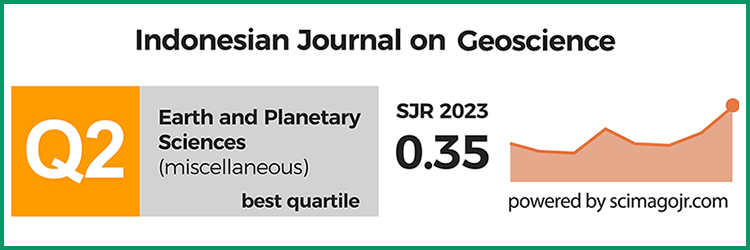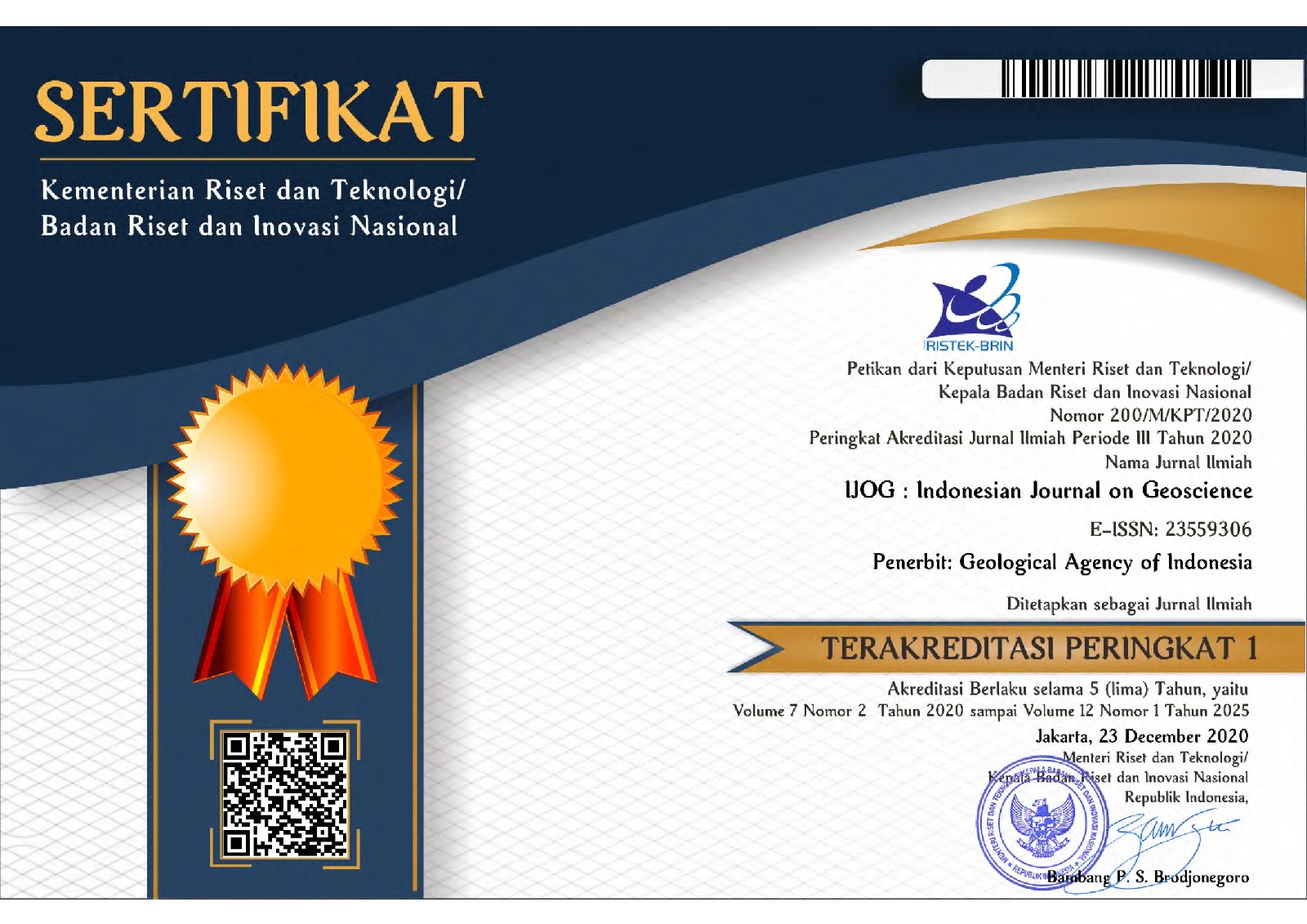Precipitation of Calcite during the Deposition of Paleogene Sangkarewang Oil Shale, Ombilin Basin, West Sumatra, Indonesia
DOI:
https://doi.org/10.17014/ijog.2.3.185-197Keywords:
calcite precipitation, oil shale, depositional environment, primary productivity, Ombilin BasinAbstract
DOI: 10.17014/ijog.2.3.185-197
Geochemical and petrographical analyses were carried out to investigate the occurrence of calcite in theformer Ombilin lacustrine lake. The study involves eight samples taken from a 56 m long drill core of Sangkarewangoil shale. Geochemical investigation showed that the samples consist of varied terrigenous input represented by Si, Al, K, and Ti, and autochthonous input represented by S, total organic carbon (TOC), and d13C of bulk organic matter. Along the drill core profile the abundance of autochthonous input decreases upwards, while that of terrigenous input oppositely increases upwards. Petrographical analysis revealed that calcite is a major mineral in the samples. In this study, the abundance of calcite could be represented by the abundance of Ca, as calcite is the only significant Ca containing mineral. Ca is abundant in the samples (8.4% in average) and its concentration varies similarly with those of S, TOC, and d13C, suggesting that the element as well as calcite incorporates the autochthonous input. Thevariation of calcite abundance in the drill core profile is considered to be related with primary productivity changes during the development of the former lake. Higher primary productivity represented by more positive of d13C value(-24.8‰) during the deposition of the lower part of the drill core profile promoted the higher amount of deposited organic matter. In such environment, the supersaturation of carbonate ion in lake water was also reached and significant precipitation of authigenic calcite occurred. As the lake developed, the primary productivity decreased as indicated by more negative of d13C value (eventually -26.8‰). This condition led to the decreases of deposited organic matterand calcite in the lake sediments.
References
Anggayana, K., Widayat, A.H., and Widodo, S., 2014. Depositional environment of the Sangkarewang oil shale, Ombilin basin, Indonesia. Journal of Engineering and Technological Science, 46, p.420-435.
Berner, R.A., 1984. Sedimentary pyrite formation: An update. Geochimica et Cosmochimica Acta, 48, p.605-615. DOI 10.1016/0016-7037(84)90089-9
Calvert, S.E. and Pederson, T.F., 1992. Organic carbon accumulation and preservation in marine sediments: how important is anoxia? In: Whelan, J. and Farrington, J.W. (Ed.), Productivity, Accumulation and Preservation of Organic Matter in Recent and Ancient Sediments. Columbia University Press, New York, p.231- 263. DOI 10.1017/S0016756800023335
Claypool, G.E. and Kaplan, I.R., 1974. The origin and distribution of methane in marine sediments, In: Kaplan, I.R. (Ed.), Natural Gases in Marine Sediments. Plenum Press, New York, p. 99-140. DOI 10.1007/978-1-4684-2757-8_8
de Smet, M.E.M. and Barber, A.J., 2005. Chapter 7: Tertiary Stratigraphy. Sumatra. In: Barber, A.J., Crow, M.J., and Milsom, J.S. (Ed.), Sumatra - Geology, Resources, and Tectonic Evolution. Geological Society, London, Memoirs, 31, p.86-97.
Demaison, G.J. and Moore, G.T., 1980. Anoxic environments and oil source bed genesis. Organic Geochemistry, 2, p.9-31. DOI 10.1016/0146-6380(80)90017-0
Drljepan, M., McCarthy, F.M.G., and Hubeny, J.B., 2014. Natural and cultural eutrophication of Sluice Pond, Massachusetts, USA, recorded by algal and protozoan microfossils. Holocene, 24, p.1731-1742. DOI 10.1177/0959683614551227
Dypvik, H. and Harris, N.B., 2001. Geochemical facies analysis of fine-grained siliciclastics using Th/U, Zr/Rb and (Zr+Rb)/Sr ratios. Chemical Geology ,181, p.131-146. DOI 10.1016/S0009-2541(01)00278-9
Einsele, G. and Hinderer, M., 1998. Quantifying denudation and sediment-accumulation systems (open and closed lakes): basic concepts and first results. Palaeogeography, Palaeoclimatology, Palaeoecology, 140, p.7-21. DOI 10.1016/S0031-0182(98)00041-8
Eusterhues, K., Heinrichs, H., and Schneider, J., 2005. Geochemical response on redox fluctuations in Holocene lake sediments, Lake Steisslingen, Southern Germany. Chemical Geology, 222, p.1-22. DOI 10.1016/j.chemgeo.2005.06.006
Fatimah and Ward, C.R., 2009. Mineralogy and organic petrology of oil shales in the Sangkarewang Formation, Ombilin Basin, West Sumatra, Indonesia. International Journal of Coal Geology, 77, p.424-435. DOI 10.1016/j.coal.2008.04.005
Heyng, A.M., Mayr, C., Lücke, A., Wissel, H., and Striewski, B., 2014. Late Holocene hydrologic changes in northern New Zealand inferred from stable isotope values of aquatic cellulose in sediments from Lake Pupuke. Journal of Paleolimnology, 51, p.485-497. DOI 10.1007/s10933-014-9769-3
Hodell, D.A., Brenner, M., Kanfoush, S.L., Curtis, J.H., Stoner, J.S., Xueliang, S., Yuan, W., and Whitmore, T.J., 1999. Paleoclimate of Southwestern China for the past 50,000 yr inferred from lake sediment records. Quaternary Research, 52, p.369-380. DOI 10.1006/qres.1999.2072
Hollander, D., McKenzie, J., Hsu, K., and Huc, A., 1993. Application of an eutrophic lake model to the origin of ancient organic-carbonrich sediments. Global Biogeochemical Cycles, 7, p.157-179. DOI 10.1029/92GB02831
Hollander, D.J. and Smith, M.A., 2001. Microbially mediated carbon cycling as a control on the δ13C of sedimentary carbon in eutrophic Lake Mendota (USA): new models for interpreting isotopic excursions in the sedimentary record. Geochimica et Cosmochimica Acta, 65, p.4321-4337. DOI 10.1016/S0016-7037(00)00506-8
Kasper, T., Frenzel, P., Haberzettl, T., Schwarz, A., Daut, G., Meschner, S., Wang, J., Zhu, L., and Mäusbacher, R., 2013. Interplay between redox conditions and hydrological changes in sediments from Lake Nam Co (Tibetan Plateau) during the past 4000 cal BP inferred from geochemical and micropaleontological analyses. Palaeogeography, Palaeoclimatology, Palaeoecology, 392, p.261-271. DOI 10.1016/j.palaeo.2013.09.027
Koesoemadinata, R.P. and Matasak, Th., 1981. Stratigraphy and sedimentation Ombilin basin, Central Sumatra (West Sumatra Province). Proceedings of Indonesian Petroleum Association 10th Annual Convention, Jakarta, p.217-249.
Koning, T., 1985. Petroleum geology of the Ombilin intermontane basin, West Sumatra. Proceedings of Indonesian Petroleum Association 14th Annual Convention, Jakarta, p.117-137.
Meyers, P.A., 2003. Applications of organic geochemistry to paleolimnological reconstructions: a summary of examples from the Laurentian Great Lakes. Organic Geochemistry, 34, p.261-289. DOI 10.1016/S0146-6380(02)00168-7
Meyers, P.A. and Ishiwatari, R., 1993. Lacustrine organic geochemistry - an overview of indicators of organic matter sources and diagenesis in lake sediments. Organic Geochemistry, 20, p.867-900. DOI 10.1016/0146-6380(93)90100-P
Pederson, T.F. and Calvert, S.E., 1990. Anoxia vs. Productivity: what controls the formation of organic-carbon-rich sediments and sedimentary rocks. American Association of Petroleum Geologists, Bulletin, 74, p.454-466. DOI 10.1306%2F0C9B232B-1710-11D7-8645000102C1865D
Raiswell, R. and Berner, R.A., 1985. Pyrite formation in euxinic and semi-euxinic sediments. American Journal of Science, 285, p.710-724. DOI 10.2475/ajs.285.8.710
Silitonga, P.H. and Kastowo, D., 1975. Geological Map of the Solok Quadrangle (5/VIII), Sumatra, Scale 1:250000. Geological Survey of Indonesia, Ministry of Mines, Bandung.
Smittenberg, R.H., Pancost, R.D., Hopmans, E.C., Paetzel, M., and Sinninghe Damsté, J.S., 2004. A 400-year record of environmental change in an euxinic fjord as revealed by the sedimentary biomarker record. Palaeogeography, Palaeoclimatology, Palaeoecology, 202, p.331-351. DOI 10.1016/S0031-0182(03)00642-4
Teranes, J.L. and Bernasconi, S.M., 2005. Factors controlling δ13C values of sedimentary carbon in hypertrophic Baldeggersee, Switzerland, and implications for interpreting isotope excursions in lake sedimentary records. Limnology and Oceanography, 50, p.914-922. DOI 10.4319/lo.2005.50.3.0914
Teranes, J.L., McKenzie, J.A., Lotter, A.F., and Sturm, M., 1999. Stable isotope response to lake eutrophication: Calibration of a high-resolution lacustrine sequence from Baldeggersee, Switzerland. Limnology and Oceanography, 44, p.320-333.
Tribovillard, N., Algeo, T., Lyons, T.W., and Riboulleau, A., 2006. Trace metals as paleoredox and paleoproductivity proxies: an update. Chemical Geology, 232, p.12-32. DOI 10.1016/j.chemgeo.2006.02.012
Vogel, H., Wagner, B., Zanchetta, G., Sulpizio, R., and Rosén, P., 2010. A paleoclimate record with tephrochronological age control for the last glacial-interglacial cycle from Lake Ohrid, Albania and Macedonia. Journal of Paleolimnology, 44, p.295-310. DOI 10.1007/s10933-009-9404-x
Widayat, A.H., Anggayana, K., Syafrizal, Heriawan, M.N., Hede, A.N.H., and Hakim, A.Y.A., 2013. Organic matter characteristics of the Kiliran and Ombilin oil shales, Indonesia. Procedia Earth and Planetary Science, 6, p.91-96. DOI 10.1016/j.proeps.2013.01.013
Wu, D., Zhou, A., Chen, X., Yu, J., Zhang, J., and Sun, H., 2015. Hydrological and ecosystem response to abrupt changes in the Indian monsoon during the last glacial, as recorded by sediments from Xingyun Lake, Yunnan, China. Palaeogeography, Palaeoclimatology, Palaeoecology, 421, p.15-23. DOI 10.1016/j.palaeo.2015.01.005
Xu, H., Ai, L., Tan, L., and An, Z., 2006. Stable isotopes in bulk carbonates and organic matter in recent sediments of Lake Qinghai and their climatic implications. Chemical Geology, 235, p.262-275. DOI 10.1016/j.chemgeo.2006.07.005
Yu, Z., Liu, X., Wang, Y., Chi, Z., Wang, X., and Lan, H., 2014. A 48.5-ka climate record from Wulagai Lake in Inner Mongolia, Northeast China. Quaternary International, 333, p.13-19. DOI 10.1016/j.quaint.2014.04.006



















